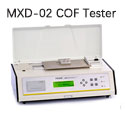15
2012
Plastics Film and Sheeting – Coefficient of Friction (ISO 8295)
| The ISO 8295 test method is used to investigate the static and dynamic frictional properties of film and sheet plastics when sliding on itself or other materials. This method is intended to be used for non-sticky plastic film and sheeting of up to 0.5 mm thickness.
In principle, the test specimen is supported on a friction table, consisting of a horizontal test table, a sled, and a driving mechanism via a pulley to produce a relative motion between the sled and the test table. One piece of the material is attached to the table with double sided adhesive tape. The other piece is wrapped around the sled and secured on the top of the sled with double-sided adhesive tape. This sled is then placed onto the specimen on the table. The test machine is driven at a constant rate of displacement, which drags the sled across the length of the specimen on the table. The force is recorded, and test results are calculated for static and kinetic coefficient of friction. We use a fixed force sensor to obtain a high precise testing result, which is reducing the influence caused by the shock of the driving mechanism. Therefore, testing accuracy of our instrument can be better than the requirement of ISO 8295, which is better than 0.5% of reading value. We suggest reviewing ISO 8295 to fully understand the test fixture and results requirements. |
Leave a comment
Videos for Friction Tester
Recent Posts
- Coefficient of Friction Test of Paint Film or painted panels
- The Significance and Test Method of Coefficient of Friction of Medical Gloves
- Labthink upcoming events, unmissable exhibitions!
- What are the Uses of the Coefficient Of Friction Tester
- Precision Slide Angle Coefficient of Friction Testing by Labthink

 An article by
An article by 






